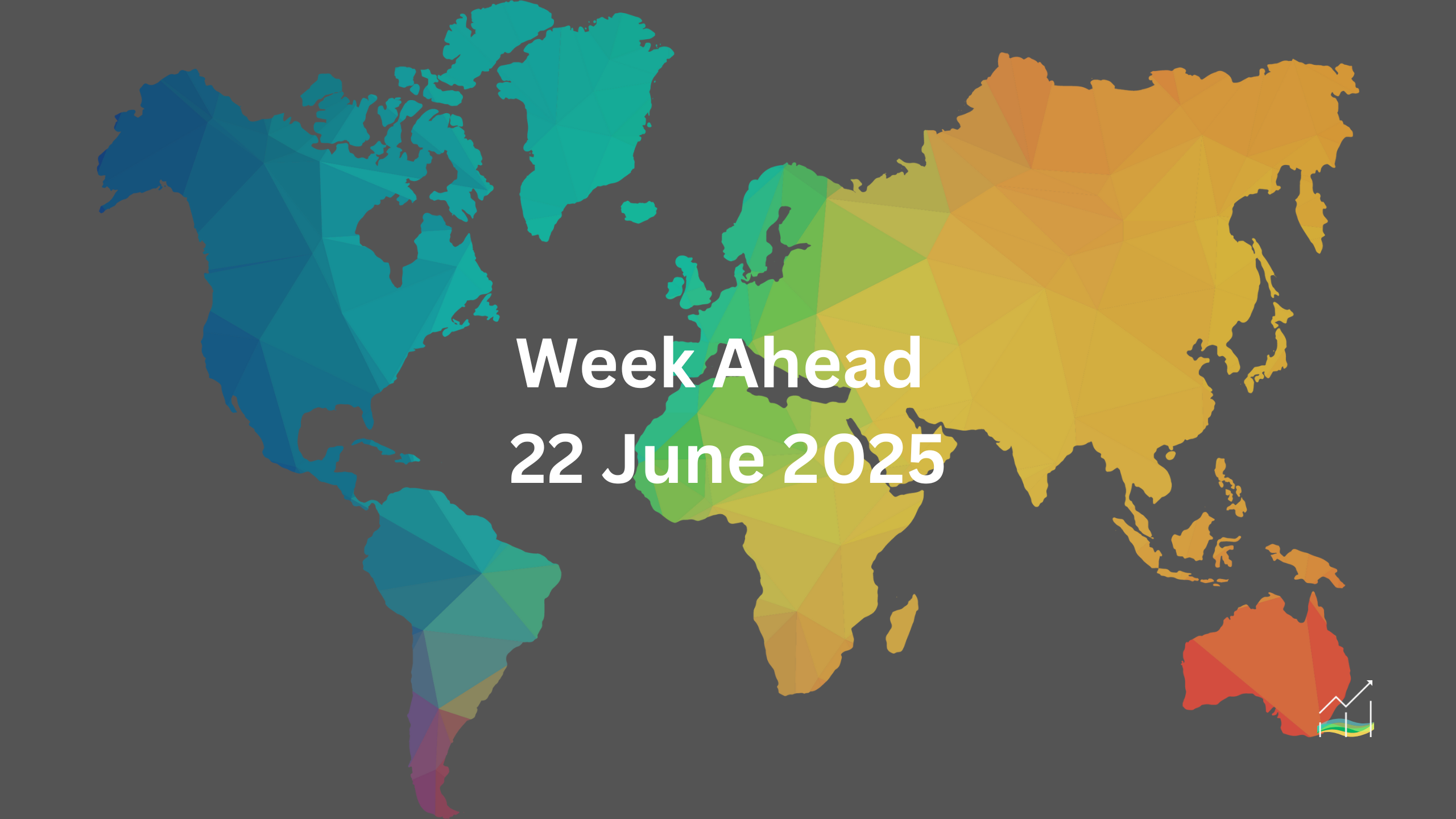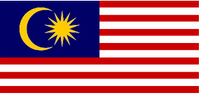22/06/2025 Week Ahead

Geopolitics & Tariffs Simmer Beneath the Surface
Key Takeaways:
- Oil remains the main market responder to the Israel-Iran war, while broader markets remain calm.
- US data continues to underperform, but the Fed signals no urgency for policy changes.
- Gold posted its first weekly decline in three, while the dollar strengthened broadly.
- US tariff tensions rise again, with steel and aluminum duties doubled.
- NATO meets amid rising geopolitical uncertainty in the Middle East and Ukraine.
- Markets look to global PMIs and Mexico’s central bank decision this week.
Despite the intensifying Israel-Iran conflict and ongoing war in Ukraine, broader capital markets have shown surprising composure. The most notable response remains in oil, with WTI climbing another 2.7% last week after a strong rally the week prior. Gasoline prices have followed suit. However, outside of energy, the market impact has been muted. Gold retreated nearly 2% after a three-week run, and the dollar strengthened against all G10 currencies.
The US economy continues to deliver disappointing data, with recent weakness in retail sales, industrial output and housing starts. Yet the Federal Reserve has signaled no urgency to adjust policy. While Fed Governor Waller opened the door to a possible rate cut as early as July, the market remains focused on September, where odds of a cut have climbed to around 80%.
Tariff tensions are once again in play, with the US recently doubling duties on steel and aluminum and a critical deadline on reciprocal tariffs approaching on July 9. Meanwhile, diplomatic efforts to secure trade deals are gaining urgency. On the geopolitical front, NATO prepares for its upcoming meeting with dual concerns over Ukraine and the Middle East. President Trump is expected to make a decision on increased US military involvement in the coming fortnight. Questions remain about the effectiveness of potential strikes on Iran’s deeply buried nuclear facilities.
In the week ahead, the economic calendar is relatively light. Flash PMIs will provide fresh insights into global activity, and Tokyo’s June CPI is projected to ease slightly. Mexico’s central bank is also in focus, where the expected rate cut may be smaller than forecast due to persistent inflationary pressures.
United States of America
Overview
The US dollar's relationship with tariffs has evolved. Initially, rising tariffs were expected to support the dollar, but market reactions have defied this assumption. Recent history suggests that the greenback tends to weaken when tariff threats escalate, even as interest rates rise. With President Trump preparing to issue formal notifications on bilateral tariffs ahead of the July deadline for ending the reciprocal tariff postponement, market focus is intensifying. Additionally, if the US becomes directly involved in the expanding Israel-Iran conflict, or if the war spills over further, the dollar may experience increased volatility. Another factor affecting the region is the elevated cost of shipping insurance, which appears to be restricting traffic through the Gulf of Hormuz more than Iranian activity itself.
The dollar may also be influenced by a range of economic reports this week. Although recent Fed commentary suggests that policymakers are in no rush to react to upcoming data, several important indicators are on the calendar. Attention will be on the May goods trade balance amid ongoing tariff concerns, as well as jobless claims which recently climbed to levels last seen in August 2023. A surge in Boeing orders is expected to boost the headline durable goods figure after April’s steep drop. Markets will also scrutinise personal income and spending data to refine GDP expectations for the second quarter, with projections ranging from 1.4% to 3.4%. Lastly, inflation signals will be taken from the PCE deflator, with both headline and core readings expected to edge higher.
Technically, the Dollar Index ended last week on a firm note, climbing above multiple recent resistance levels. Momentum indicators suggest a pause or correction may be ahead, though near-term signals remain constructive. A bullish crossover of the five-day moving average above the 20-day could support further gains.
Economic Drivers
- Rising tariff threats ahead of the July deadline are putting downward pressure on the dollar.
- Market reactions show that higher US rates have not consistently supported the currency.
- A widening Middle East conflict or direct US involvement could increase dollar volatility.
- Insurance costs are restricting traffic in the Gulf of Hormuz more than military threats.
Data and Events
- 23 June 2025: FOMC Members Speaks.
- 23 June 2025: Flash Manufacturing & Services PMI.
- 23 June 2025: Existing Home Sales.
- 24 June 2025: Fed Chair Powell Testifies.
- 24 June 2025: CB Consumer Confidence.
- 24 June 2025: Richmond Manufacturing Index.
- 25 June 2025: Fed Chair Powell Testifies.
- 25 June 2025: New Home Sales.
- 26 June 2025: Final GDP.
- 26 June 2025: Unemployment Claims
- 26 June 2025: Durable Goods Orders.
- 26 June 2025: Pending Home Sales.
- 27 June 2025: PCE Price Index.
- 27 June 2025: UoM Consumer & Inflation.
Price Action
- Dollar Index closed above key resistance levels including the downtrend line from mid-May.
- Momentum indicators suggest a short-term consolidation or correction is likely.
- A bullish moving average crossover is forming, supporting near-term upside.
- The next target zone lies between 100.00 and 100.50.
Key Points:
- Dollar weakens under elevated tariff threats, despite rate expectations.
- New US tariffs and trade tensions remain a critical risk for markets.
- Durable goods and PCE data are key drivers for short-term sentiment.
- Dollar Index technicals show bullish bias but may consolidate near term.
Australia
Overview
The Australian dollar remains one of the weakest performers in the G10 so far this year, closely rivalled only by the Canadian dollar. The currency’s struggles have persisted through heightened geopolitical risk, including the Israeli strike on Iran in mid-June, during which both the Australian and New Zealand dollars were among the hardest hit. Recent correlation trends show a strong relationship between the Australian dollar and the US Dollar Index, with a rolling 30-day correlation nearing 0.75. Its linkage to the Canadian dollar also remains significant, while its correlation with gold has weakened, falling to its lowest level since early April.
Domestic economic data has done little to lift sentiment. Last week’s disappointing employment figures marked the second overall monthly job loss this year and included a decline in the participation rate, pushing the currency to its lowest in two and a half weeks. While the upcoming preliminary PMI release is unlikely to carry much weight, markets will closely watch the May CPI print. Inflation has been stable at 2.4% for three consecutive months, but the central bank is expected to continue focusing on the more comprehensive quarterly data. Nevertheless, the market sees a high likelihood of another rate cut at the Reserve Bank of Australia’s meeting early next month, with two more cuts possibly following before year-end. This positions the RBA as one of the more aggressive central banks in the G10, albeit from a delayed starting point.
Technically, the Australian dollar appears to remain in a corrective phase. After rebounding slightly, it failed to hold gains and returned to near-term lows. Momentum indicators remain weak and a bearish moving average crossover is expected soon, suggesting that the recent low may not yet be the bottom. Support is seen in the $0.6400 to $0.6425 zone.
Economic Drivers
- The Australian dollar remains among the weakest G10 currencies in 2025.
- The currency is heavily correlated with the US Dollar Index and, to a lesser extent, the Canadian dollar.
- Its correlation with gold has weakened significantly since early April.
- The Reserve Bank of Australia is expected to cut rates again in July and possibly two more times this year.
- The central bank prioritises quarterly inflation data over monthly prints.
- Poor May employment figures have reinforced expectations for further monetary easing.
Data and Events
- 23 June 2025: Flash Manufacturing & Services PMI.
- 25 June 2025: CPI.
Price Action
- AUD/USD dropped to a 2.5-week low near $0.6445 following weak employment data.
- Brief recovery stalled near $0.6500 before falling back to retest recent lows.
- Momentum indicators remain soft, indicating that downside pressure is still in play.
- A bearish crossover of the 5-day and 20-day moving averages is expected early in the week.
- Key support lies in the $0.6400 to $0.6425 zone.
Key Points:
- Australian dollar remains under pressure as one of the G10's weakest performers.
- May CPI is the key domestic event but unlikely to shift central bank focus from quarterly data.
- Market expects the RBA to be among the most dovish G10 central banks in the second half of the year.
- Price action suggests downside risks remain for the Australian dollar.
Canada
Overview
The Canadian dollar has shifted its sensitivity from equity risk and interest rate changes toward tracking the broader direction of the US dollar. The 30-day correlation between the CAD/USD exchange rate and the US Dollar Index is now slightly above 0.70, a level rarely reached in recent years. For context, this correlation was below 0.20 as recently as February, its weakest point since late 2021. This shift suggests that broad USD sentiment is now the dominant driver for the Canadian dollar, overtaking previously influential domestic factors.
This week, markets will focus on two key economic indicators: May inflation data and April GDP. In April, Canada's headline inflation slowed to 1.7% from 2.3%, yet core measures rose and influenced the Bank of Canada’s decision to hold rates steady. Given that the central bank has signalled a near end to its rate-cut cycle, any signs of persistent core inflation could reinforce this stance. Meanwhile, GDP growth in Q1 was reported at 2.2% annualised, but many economists expect a contraction in Q2. A weak April GDP figure would not be surprising, considering that February output contracted by 0.2% before posting only a 0.1% increase in March. Markets are currently pricing in just one more rate cut before year-end.
Technically, the Canadian dollar weakened last week, as the US dollar rebounded from its lowest level since October. The pair rose to just under CAD1.3750 and closed above its 20-day moving average for the first time since late May. A bullish moving average crossover is developing, which could open the door to further near-term gains for USD/CAD toward CAD1.3780 or even the CAD1.3835–1.3860 resistance zone.
Economic Drivers
- The Canadian dollar now tracks the US Dollar Index more closely than equities or interest rates.
- 30-day CAD/USD correlation with the Dollar Index is at multi-year highs above 0.70.
- April’s headline CPI declined but core measures rose, leading the Bank of Canada to hold rates.
- GDP forecasts suggest Canada may contract in Q2 following weak monthly data in February and March.
- The Bank of Canada has signalled its rate-cutting cycle is nearly complete, with one final cut priced in.
Data and Events
- 24 June 2025: CPI.
- 27 June 2025: GDP.
Price Action
- USD/CAD rebounded from a multi-month low near CAD1.3540 to just below CAD1.3750.
- Closed the week above the 20-day moving average for the first time since 20 May.
- A bullish crossover of the 5-day and 20-day moving averages is expected early in the week.
- Short-term resistance is located at CAD1.3780, with the next zone at CAD1.3835–1.3860.
Key Points:
- CAD is now primarily driven by broad US dollar trends rather than domestic fundamentals.
- CPI and GDP releases will help clarify the outlook for Canada’s growth and inflation.
- The Bank of Canada remains cautious but is near the end of its policy easing.
- USD/CAD has regained upward momentum with potential for further gains.
China
Overview
China continues to exert strong control over the yuan, maintaining a strategy focused on broad exchange rate stability rather than short-term responsiveness to economic data or news developments. Despite introducing a slight increase in the flexibility of the daily fix, authorities remain committed to controlling the yuan’s value against the dollar. In the current macroeconomic context, where China is struggling to meet its growth targets and persistent deflationary pressures linger, a stronger yuan driven solely by a weaker US dollar may not align with Beijing’s objectives.
The People's Bank of China (PBOC) has been gradually lowering the daily reference rate for the dollar, effectively tightening the upper boundary of its allowed trading band. This tool remains one of the most direct and influential methods for guiding the yuan. Late last week, the daily fix was set at CNY7.1695, the lowest in three months. These steady adjustments underscore China's commitment to a managed exchange rate regime, even as the global economic landscape evolves.
On the data front, China is set to release industrial profit figures. Although there have been media reports highlighting the number of loss-making firms in China, such observations can be misleading without appropriate context. Losses in some sectors are not inherently negative or unique to China. In many cases, firms prioritise market share over immediate profitability, particularly in economies where capital is allocated through banks rather than open markets. This structural characteristic aligns more with the "Rhine model" of capitalism rather than the market-led systems found in the US or UK.
Economic Drivers
- The yuan remains under tight official management with minimal sensitivity to economic data.
- The PBOC aims to maintain exchange rate stability rather than allow market-driven volatility.
- Growth momentum in China remains weak, with deflationary conditions persisting.
- A stronger yuan caused by US dollar weakness may work against China’s economic objectives.
- Many Chinese firms focus on market share rather than maximising short-term profit, reflecting deeper structural traits of China's economic model.
Data and Events
- 23 June 2025: Foreign Direct Investment.
- 26 June 2025: CB Leading Index.
Price Action
- The PBOC continues to lower the USD/CNY daily reference rate, tightening the upper limit of the trading band.
- Last week’s fix at CNY7.1695 marked the lowest level in three months.
- The offshore yuan (CNH) has been consolidating in a narrow range between CNH7.1650 and CNH7.2000 since early June.
Key Points:
- China is focused on maintaining yuan stability rather than reacting to short-term market developments.
- The PBOC is using the daily fix to limit yuan appreciation in a weak economic environment.
- Industrial profit data will offer further insight into the health of China’s corporate sector.
- Currency remains in a tight range due to strong official guidance.
Europe
Overview
The euro remains the most liquid and widely used alternative to the US dollar, often gaining when the greenback weakens. This role continues to provide underlying support. Market sentiment around the European Central Bank (ECB) has also played a role, with officials signalling that the rate-cutting cycle is close to ending. After one more expected reduction before year-end, the deposit rate would reach 1.75 percent, which the ECB views as close to its neutral level.
Economic data from the eurozone is increasingly important for market direction. The ECB appears to place considerable emphasis on the Purchasing Managers' Index (PMI) readings, and recent composite figures for April and May suggest that the strongest phase of euro area growth may already be behind us. Additionally, upcoming May auto registration data will act as a proxy for consumer spending. The April data showed a modest increase of 1.3 percent year-on-year, marking the first positive annual reading this year. Germany’s June IFO survey will also be closely watched, especially as business sentiment has been improving steadily throughout 2025, already surpassing the full-year performance of 2024.
From a price perspective, the euro has pulled back after reaching its highest level since October 2021. Although it found support just ahead of the 20-day moving average, it has struggled to break above the $1.1550 to $1.1560 resistance zone. If this level continues to cap gains, the consolidation could persist. A decisive move below $1.1440 may open the door to $1.1380 in the near term.
Economic Drivers
- The euro is supported by its role as the most liquid alternative to the US dollar.
- ECB guidance suggests only one more rate cut is expected this year, likely ending the easing cycle.
- The deposit rate is expected to settle at 1.75 percent, a level considered near the neutral rate.
- PMI data is closely watched by the ECB and reflects recent slowing momentum in growth.
- Auto registrations and German business sentiment offer additional insight into regional demand.
Data and Events
- 23 June 2025: Flash Manufacturing & Services PMI.
- 24 June 2025: German ifo Business Climate.
- 27 June 2025: French Prelim CPI.
- 27 June 2025: Spanish Flash CPI.
Price Action
- The euro retreated from a high of $1.1630 and found support near $1.1445.
- It has remained above the 20-day moving average since late May.
- Resistance near $1.1550–1.1560 capped gains ahead of the weekend.
- A break below $1.1440 could lead to a test of $1.1380.
Key Points:
- ECB’s rate cycle is nearing completion, which supports euro stability.
- Eurozone PMI and IFO data are central to short-term expectations.
- Recent price action suggests consolidation unless key levels are broken.
- Market focus remains on whether eurozone growth can maintain momentum.
Japan
Overview
The yen’s behaviour has shifted in recent weeks, with its sensitivity to US interest rates increasing significantly. The 30-day rolling correlation between changes in the USD/JPY exchange rate and the US 10-year Treasury yield has climbed to 0.48, up from below 0.10 just a month ago. Despite ongoing geopolitical tension in the Middle East, particularly the Israel-Iran conflict, the yen has not displayed its usual safe-haven characteristics. This may be due to the market interpreting the situation as an oil supply shock rather than a broader financial risk event.
Japan currently holds the highest inflation rate among G10 countries, yet the Bank of Japan remains cautious. Despite elevated prices, rate hikes have not followed, and both the domestic bond and equity markets are the worst performing within the G7 so far this year. Governor Ueda has softened his messaging, indicating that while future hikes are possible if conditions align, the inflation target remains unmet. This cautious stance has contributed to a shift in expectations, with the swaps market now pricing the policy rate at just under 0.60 percent by year-end, down from 0.85 percent in March.
The key economic release this week will be Tokyo’s June CPI, which typically leads the national inflation figure and serves as a reliable indicator. Additional data will include employment figures and retail sales, but these are unlikely to overshadow the importance of the inflation print.
Technically, the dollar registered its strongest weekly gain this year against the yen, rising nearly 1.40 percent and breaking to a new monthly high. A breach of the JPY146.30 resistance could open the way toward JPY147.00 to JPY147.15. While momentum remains constructive, the first layer of support lies around JPY144.35, with the dollar maintaining a floor above JPY145 since late last week.
Economic Drivers
- The yen's sensitivity to US yields has increased sharply over the past month.
- Geopolitical risks have failed to trigger a safe-haven bid for the yen, with markets focused on energy implications.
- Japan has the highest inflation in the G10, but the Bank of Japan remains reluctant to raise rates.
- Japanese bond and equity markets are underperforming within the G7.
- Governor Ueda maintains a cautious tone, stressing the inflation target is not yet met.
- Rate expectations for year-end have fallen, indicating limited policy tightening ahead.
Data and Events
- 23 June 2025: Flash Manufacturing & Services PMI.
- 23 June 2025: BOJ Core CPI.
- 27 June 2025: Tokyo Core CPI.
- 27 June 2025: Unemployment Rate.
- 27 June 2025: Retail Sales.
Price Action
- USD/JPY rose nearly 1.40 percent last week, posting its strongest gain this year.
- The pair reached a monthly high just above JPY146.20 before the weekend.
- A move above JPY146.30 could target the JPY147.00–147.15 zone.
- Support is seen around JPY144.35, with price action holding above JPY145 late last week.
- Momentum indicators remain constructive, suggesting continued upside potential.
Key Points:
- The yen is increasingly influenced by US yields, not safe-haven demand.
- Market expectations for BoJ tightening have softened in recent months.
- Tokyo CPI will be the main economic highlight this week.
- USD/JPY remains in a strong uptrend with resistance near JPY147.
United Kingdom
Overview
Sterling's strong performance this year has been driven more by weakness in the US dollar than by domestic economic strength. Year-to-date, the pound has appreciated 7.6 percent against the dollar, but only around 1.8 percent of that gain has come since the end of April, even as interest rate expectations have risen on both sides of the Atlantic. The UK swaps market has shifted less dovish, now pricing in a year-end base rate around 3.75 percent, up from 3.50 percent previously. At the same time, expectations for the US Fed funds rate have also risen, aligning near the same 3.75 percent level.
This week, the UK will revise its Q1 GDP data. The economy had shown strength early in the year with a 0.7 percent quarterly expansion, the strongest among G7 countries. However, signs of a slowdown have emerged. April GDP contracted by 0.3 percent, the sharpest monthly decline since October 2023. Meanwhile, May retail sales fell by 2.7 percent, far worse than expectations and more than offsetting the prior month's gains. The composite PMI also showed weakness in April, slipping to 48.5 before recovering slightly to 50.3 in May. The preliminary reading for June will be closely watched to assess whether this recovery can be sustained.
Despite weaker data and a dovish hold by the Bank of England, sterling has remained relatively resilient. The BoE's 6-3 vote to leave rates unchanged highlighted internal division and caution. While the pound fell 1.1 percent following the GDP disappointment, it managed to recover briefly above $1.3500 before meeting resistance and retreating toward $1.3440. With key support seen at $1.3380, a break lower could trigger further declines. Technical signals have weakened, with a bearish crossover of the 5-day and 20-day moving averages, and near-term resistance is noted around $1.3480.
Economic Drivers
- Sterling's strength reflects broad US dollar weakness more than domestic optimism.
- Swaps market has raised expectations for the year-end base rate to 3.75 percent.
- UK rate outlook aligns with the Fed, with both expected near 3.75 percent by year-end.
- UK growth faltered in Q2 after strong Q1 GDP performance.
- Retail sales and PMI data have shown signs of weakening demand.
- The BoE remains cautious, with a 6-3 vote to hold rates steady.
Data and Events
- 23 June 2025: Flash Manufacturing & Services PMI.
- 24 June 2025: BOE Gov Bailey Speaks.
- 24 June 2025: MPC Members Speaks.
- 26 June 2025: BOE Gov Bailey Speaks.
Price Action
- GBP/USD fell sharply to $1.3380 on June 17 after weak GDP data, then rebounded above $1.3500.
- Sellers emerged near $1.3500, pushing the pair back toward $1.3440 by the weekend.
- A break below $1.3380 could trigger another 50 pip drop.
- The 5-day moving average has crossed below the 20-day for the first time since May 19.
- Initial resistance is located near $1.3480.
Key Points:
- Sterling gains are primarily driven by dollar weakness, not UK fundamentals.
- UK data has turned softer in Q2, raising concerns about sustained growth.
- The BoE remains cautious despite rising inflation and weak demand indicators.
- GBP/USD faces key technical levels, with downside risk if support fails.
© 2025 SKONE Enterprise (003319453-V). All rights reserved.
The content on this site is for informational purposes only and does not constitute financial advice.


